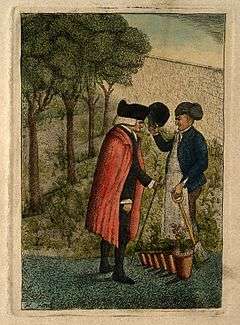John Hope (botanist)
| John Hope | |
|---|---|
 | |
| Born |
10 May 1725 Edinburgh |
| Died |
10 November 1786 (aged 61) Edinburgh |
| Nationality | Scottish |
| Fields | Botany, medicine |
| Institutions |
President, Royal College of Physicians of Edinburgh (1784-1786) King's Botanist (1761-86) Professor of Botany, University of Edinburgh |
| Alma mater |
University of Edinburgh University of Paris |
| Author abbrev. (botany) | Hope |
| Children | Thomas Charles Hope |
Professor John Hope FRSE FRS PRCPE (10 May 1725 – 10 November 1786) was a Scottish physician and botanist. Although he did enormous work on plant classification and plant physiology, due to an absence of publications, he is now best known as an early supporter of Carl Linnaeus's system of classification.
In 1783 he was a joint founder of the Royal Society of Edinburgh.
In 1784 Hope was elected as president of the Royal College of Physicians of Edinburgh (1784-6).
Early life
Born in Edinburgh on 10 May 1725, John Hope was the son of surgeon Robert Hope and Marion Glas, and a grandson of Archibald Hope, Lord Rankeillor, a Senator of the College of Justice who was in turn the son of Sir John Hope, 2nd Baronet.
He was educated at Dalkeith Grammar School, then studied medicine at the University of Edinburgh. He took leave to study botany under Bernard de Jussieu at the University of Paris, but returned to his studies in Scotland, graduating MD from the University of Glasgow in 1750.[1]
For the next decade he practiced medicine, indulging in botany in his spare time. With the death of Charles Alston in 1760, he succeeded him as King's Botanist and as Professor of Botany and Materia Medica at the University of Edinburgh. However Hope saw his responsibility for materia medica as a threat to his work in botany, and therefore arranged for the chair to be split: Hope became Professor of Medicine and Botany, and a separate chair of Materia Medica are created.[2]
In 1763, Hope succeeding in combining the gardens and collections at Trinity Hospital and Holyrood to a new, combined site on the road to Leith. He also succeeded in obtaining a permanent endowment for the garden, thus establishing arguably the first ever "Royal Botanic Garden". Though he published only a few papers, and is therefore little remembered as a botanist, he made many early physiological experiments. These informed his teaching, but were not published, and were only discovered in his unpublished manuscripts many years after his death.[2] He was elected a Fellow of the Royal Society in February 1767.[3] He was appointed Physician in Ordinary to the Royal Infirmary of Edinburgh in 1768.
In later life he lived at High School Yards on the southern edge of the Old Town.[4]
He died in Edinburgh on 10 November 1786, and was interred at Greyfriars Kirkyard.[1] He was the father of Thomas Charles Hope, the chemist.
Botanical Reference
The genus Hopea is named after Hope.[1]
Family
He was married to Juliana Stevenson, sister of Dr Alexander Stevenson, also a joint founder of the Royal Society of Edinburgh.[6]
His children include Thomas Charles Hope FRSE.
| Academic offices | ||
|---|---|---|
| Preceded by Dr John Gardiner |
President of the Royal College of Physicians of Edinburgh 1784–1786 |
Succeeded by Dr James Hay |
References
| Wikisource has the text of the 1885–1900 Dictionary of National Biography's article about Hope, John (1725-1786). |
- 1 2 3 Waterston, Charles D; Macmillan Shearer, A (July 2006). Former Fellows of the Royal Society of Edinburgh 1783-2002: Biographical Index (PDF). I. Edinburgh: The Royal Society of Edinburgh. ISBN 978-0-902198-84-5. Retrieved 19 June 2011.
- 1 2 Balfour, Isaac Bayley (1913). "A sketch of the Professors of Botany in Edinburgh from 1670 until 1887". In Oliver, Francis Wall (ed.). Makers of British Botany. Cambridge University Press.
- ↑ "Library and Archive Cataloue". Royal Society. Retrieved 20 November 2010.
- ↑ Edinburgh and Leith Post Office Directory 1773-74
- ↑ IPNI. Hope.
- ↑ BIOGRAPHICAL INDEX OF FORMER FELLOWS OF THE ROYAL SOCIETY OF EDINBURGH 1783 – 2002 (PDF). The Royal Society of Edinburgh. July 2006. ISBN 0 902 198 84 X.